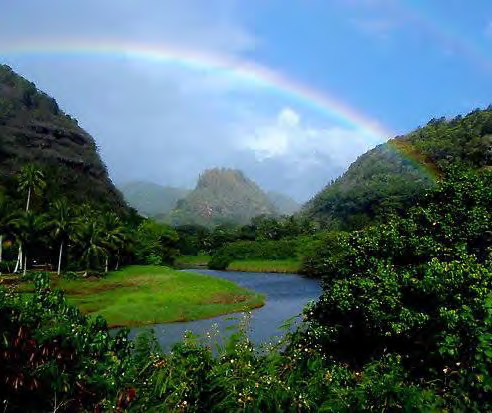By Lucas Luehrs, Conservation Land Specialist, Waimea Valley on Oahu’s North Shore
It may take a village to raise a child but it takes a community to conserve an ahupua‘a. The ancient Hawaiians lived sustainably within their ahupua‘a, which divided the islands’ resources equally among
the communities.These land divisions stretched from the top of the mountain down to the ocean allowing access to everything a community needed to thrive. The Hawaiians managed and cared for the land which allowed their population to grow with minimal negative impact on the environment.
Today’s culture is much less sustainable with a greater negative effect on the environment. The evidence is all around us; I’m sure you’ve notice the ocean turning brown after a significant rain or invasive ironwood trees falling across the road. Perhaps your friend’s property is being reclaimed by the ocean or you’re avoiding your favorite hiking trail because it’s grown over with tall itchy grass. These are all examples that could’ve been mitigated or reduced by proactively having the right plants in the right place.
Take a look around you. How many native plants do you see? Most likely there are very few or none at all. The naturalization of many introduced and invasive plant species has sped up environmental change. The aggression and tenacity of these invasive plants allow them to outcompete native species, effect the aquifer, and cause erosion. Fortunately, there are multiple organizations on the north shore that are dedicated to protecting and restoring the environment.
Waimea Valley has been slowly expanding its conservation efforts since the program started in 2007. The scope of restoration covers a majority of the ahupua‘a. This 1800 acre responsibility is a daunting task for the 4 person conservation team. Our conservation efforts rely heavily on grants and contracts, for funding and volunteers to aid in the restoration efforts. There are multiple opportunities every month to volunteer in here in the valley. If you like to hike and want to be up in the ridges, come out on Hanai Aina days, during which you will hike up to the ridge and help outplant native trees. If you want to stay down in the valley come help maintain the ‘Alae‘ula habitat around the ponds. This is also a great opportunity to learn about native plants and gain experience working with them. The gardens have multiple Hawaiian sections where you can experience different native plants including rare and endangered specimens that you may not see anywhere else. After you have volunteered for a few hours spend some time strolling through the valley and enjoy a refreshing dip at the falls.
After you’ve spent some time in the valley we encourage you to volunteer with some of the other north shore organizations. Malama Loko Ea is working to restore the fish ponds in Haleiwa and educate all ages about the importance of loko ia in communities. Malama Pupukea-Waimea has been expanding and managing the native plantings along Sharks Cove in efforts to maintain a healthy Marine Life Conservation District. North Shore Community Land Trust has recently spearheaded a sand dune restoration at Sunset Beach where coastal erosion
has taken its toll. James Campbell National Wildlife Refuge maintains the wetland habitat just beyond
the shrimp farms in Kahuku. All these organizations have at least monthly opportunities to volunteer
and learn offering all ages the opportunity to give back to their community and support the conservation efforts on the North Shore.
Find out how you can get involved today by visiting Waimea Valley’s website https://www.waimeavalley.net



